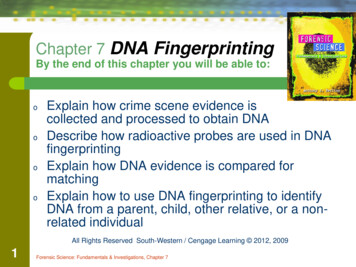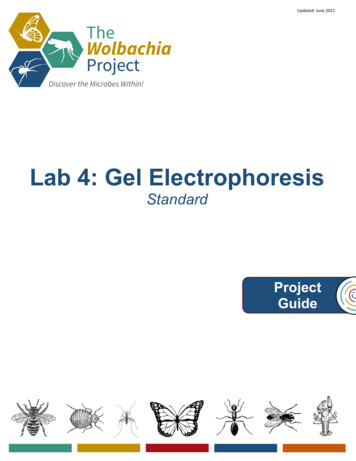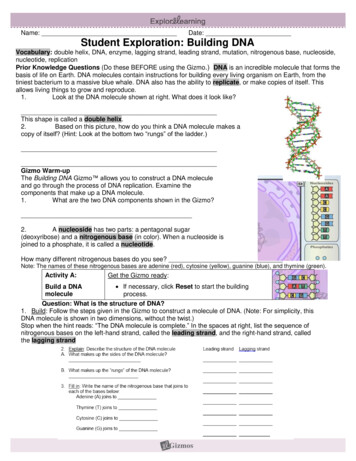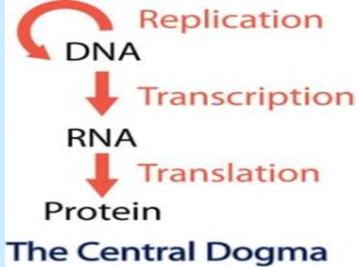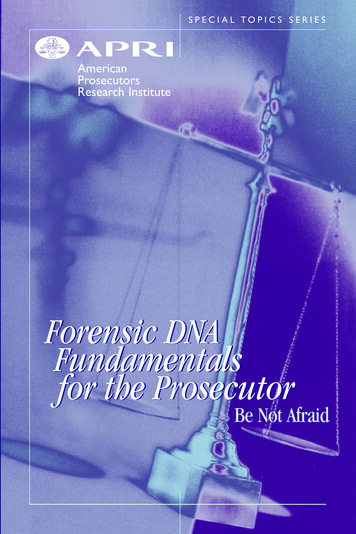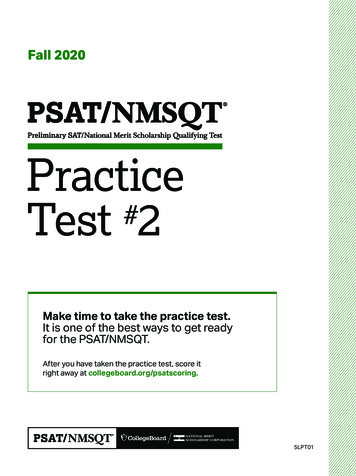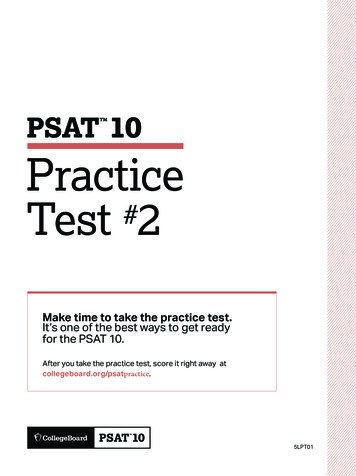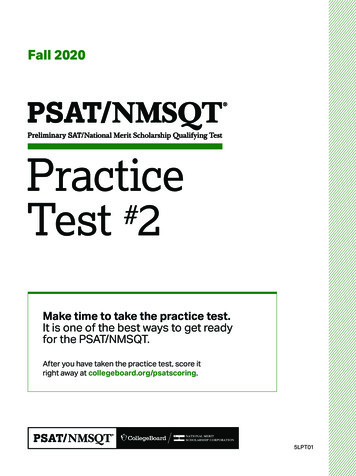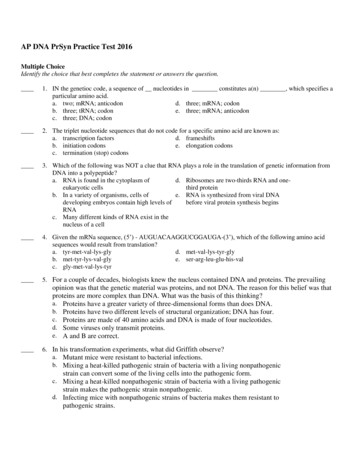
Transcription
AP DNA PrSyn Practice Test 2016Multiple ChoiceIdentify the choice that best completes the statement or answers the question.1. IN the genetioc code, a sequence of nucleotides in constitutes a(n) , which specifies aparticular amino acid.a. two; mRNA; anticodond. three; mRNA; codonb. three; tRNA; codone. three; mRNA; anticodonc. three; DNA; codon2. The triplet nucleotide sequences that do not code for a specific amino acid are known as:a. transcription factorsd. frameshiftsb. initiation codonse. elongation codonsc. termination (stop) codons3. Which of the following was NOT a clue that RNA plays a role in the translation of genetic information fromDNA into a polypeptide?a. RNA is found in the cytoplasm ofd. Ribosomes are two-thirds RNA and oneeukaryotic cellsthird proteinb. In a variety of organisms, cells ofe. RNA is synthesized from viral DNAdeveloping embryos contain high levels ofbefore viral protein synthesis beginsRNAc. Many different kinds of RNA exist in thenucleus of a cell4. Given the mRNa sequence, (5’) - AUGUACAAGGUCGGAUGA-(3’), which of the following amino acidsequences would result from translation?a. tyr-met-val-lys-glyd. met-val-lys-tyr-glyb. met-tyr-lys-val-glye. ser-arg-leu-glu-his-valc. gly-met-val-lys-tyr5. For a couple of decades, biologists knew the nucleus contained DNA and proteins. The prevailingopinion was that the genetic material was proteins, and not DNA. The reason for this belief was thatproteins are more complex than DNA. What was the basis of this thinking?a. Proteins have a greater variety of three-dimensional forms than does DNA.b. Proteins have two different levels of structural organization; DNA has four.c. Proteins are made of 40 amino acids and DNA is made of four nucleotides.d. Some viruses only transmit proteins.e. A and B are correct.6. In his transformation experiments, what did Griffith observe?a. Mutant mice were resistant to bacterial infections.b. Mixing a heat-killed pathogenic strain of bacteria with a living nonpathogenicstrain can convert some of the living cells into the pathogenic form.c. Mixing a heat-killed nonpathogenic strain of bacteria with a living pathogenicstrain makes the pathogenic strain nonpathogenic.d. Infecting mice with nonpathogenic strains of bacteria makes them resistant topathogenic strains.
e. Mice infected with a pathogenic strain of bacteria can spread the infection to othermice.7. What does transformation involve in bacteria?a. the creation of a strand of DNA from an RNA moleculeb. the creation of a strand of RNA from a DNA moleculec. the infection of cells by a phage DNA moleculed. the type of semiconservative replication shown by DNAe. assimilation of external DNA into a cell8. In trying to determine whether DNA or protein is the genetic material, Hershey and Chase made useof which of the following facts?a. DNA contains sulfur, whereas protein does not.b. DNA contains phosphorus, but protein does not.c. DNA contains nitrogen, whereas protein does not.d. DNA contains purines, whereas protein includes pyrimidines.e. RNA includes ribose, while DNA includes deoxyribose sugars.9. For a science fair project, two students decided to repeat the Hershey and Chase experiment, withmodifications. They decided to label the nitrogen of the DNA, rather than the phosphate. Theyreasoned that each nucleotide has only one phosphate and two to five nitrogens. Thus, labeling thenitrogens would provide a stronger signal than labeling the phosphates. Why won't this experimentwork?a. There is no radioactive isotope of nitrogen.b. Radioactive nitrogen has a half-life of 100,000 years, and the material would betoo dangerous for too long.c. Avery et al. have already concluded that this experiment showed inconclusiveresults.d. Although there are more nitrogens in a nucleotide, labeled phosphates actuallyhave 16 extra neutrons; therefore, they are more radioactive.e. Amino acids (and thus proteins) also have nitrogen atoms; thus, the radioactivitywould not distinguish between DNA and proteins.10. When T2 phages infect bacteria and make more viruses in the presence of radioactive sulfur, what isthe result?a. The viral DNA will be radioactive.b. The viral proteins will be radioactive.c. The bacterial DNA will be radioactive.d. both A and Be. both A and C11. Chargaff's analysis of the relative base composition of DNA was significant because he was able toshow thata. the relative proportion of each of the four bases differs within individuals of aspecies.b. the human genome is more complex than that of other species.c. the amount of A is always equivalent to T, and C to G.d. the amount of ribose is always equivalent to deoxyribose.
e. transformation causes protein to be brought into the cell.12. Which of the following can be determined directly from X-ray diffraction photographs ofcrystallized DNA?a. the diameter of the helixb. the rate of replicationc. the sequence of nucleotidesd. the bond angles of the subunitse. the frequency of A vs. T nucleotides13. Why does the DNA double helix have a uniform diameter?a. Purines pair with pyrimidines.b. C nucleotides pair with A nucleotides.c. Deoxyribose sugars bind with ribose sugars.d. Nucleotides bind with nucleosides.e. Nucleotides bind with nucleoside triphosphates.14. What kind of chemical bond is found between paired bases of the DNA double helix?a. hydrogenb. ionicc. covalentd. sulfhydryle. phosphate15. It became apparent to Watson and Crick after completion of their model that the DNA moleculecould carry a vast amount of hereditary information in which of the following?a. sequence of basesb. phosphate-sugar backbonesc. complementary pairing of basesd. side groups of nitrogenous basese. different five-carbon sugars16. Mendel and Morgan did not know about the structure of DNA; however, which of the following oftheir contributions was (were) necessary to Watson and Crick?a. the particulate nature of the hereditary materialb. dominance vs. recessivenessc. sex-linkaged. genetic distance and mappinge. the usefulness of peas and Drosophila17. Replication in prokaryotes differs from replication in eukaryotes for which of these reasons?a. The prokaryotic chromosome has histones, whereas eukaryotic chromosomes donot.b. Prokaryotic chromosomes have a single origin of replication, whereas eukaryoticchromosomes have many.c. The rate of elongation during DNA replication is slower in prokaryotes than ineukaryotes.
d. Prokaryotes produce Okazaki fragments during DNA replication, but eukaryotesdo not.e. Prokaryotes have telomeres, and eukaryotes do not.18. What is meant by the description "antiparallel" regarding the strands that make up DNA?a. The twisting nature of DNA creates nonparallel strands.b. The 5' to 3' direction of one strand runs counter to the 5' to 3' direction of the otherstrand.c. Base pairings create unequal spacing between the two DNA strands.d. One strand is positively charged and the other is negatively charged.e. One strand contains only purines and the other contains only pyrimidines.19. Suppose you are provided with an actively dividing culture of E. coli bacteria to which radioactivethymine has been added. What would happen if a cell replicates once in the presence of thisradioactive base?a. One of the daughter cells, but not the other, would have radioactive DNA.b. Neither of the two daughter cells would be radioactive.c. All four bases of the DNA would be radioactive.d. Radioactive thymine would pair with nonradioactive guanine.e. DNA in both daughter cells would be radioactive.Use Figure 16.1 to answer the following questions.Figure 16.120. Once the pattern found after one round of replication was observed, Meselson and Stahl could beconfident of which of the following conclusions?a. Replication is semi-conservative.b. Replication is not dispersive.c. Replication is not semi-conservative.d. Replication is not conservative.e. Replication is neither dispersive nor conservative.21. An Okazaki fragment has which of the following arrangements?a. primase, polymerase, ligaseb. 3' RNA nucleotides, DNA nucleotides 5'c. 5' RNA nucleotides, DNA nucleotides 3'd. DNA polymerase I, DNA polymerase IIIe. 5' DNA to 3'
22. In E. coli, there is a mutation in a gene called dnaB that alters the helicase that normally acts at theorigin. Which of the following would you expect as a result of this mutation?a. No proofreading will occur.b. No replication fork will be formed.c. The DNA will supercoil.d. Replication will occur via RNA polymerase alone.e. Replication will require a DNA template from another source.23. Which enzyme catalyzes the elongation of a DNA strand in the 5' 3' direction?a. primaseb. DNA ligasec. DNA polymerase IIId. topoisomerasee. helicase24. What determines the nucleotide sequence of the newly synthesized strand during DNA replication?a. the particular DNA polymerase catalyzing the reactionb. the relative amounts of the four nucleoside triphosphates in the cellc. the nucleotide sequence of the template strandd. the primase used in the reactione. the arrangement of histones in the sugar phosphate backbone25. Eukaryotic telomeres replicate differently than the rest of the chromosome. This is a consequence ofwhich of the following?a. The evolution of telomerase enzymeb. DNA polymerase that cannot replicate the leading strand template to its 5' endc. Gaps left at the 5' end of the lagging strand because of the need for a 3' onto whichnucleotides can attachd. Gaps left at the 3' end of the lagging strand because of the need for a primere. The "no ends" of a circular chromosome26. The enzyme telomerase solves the problem of replication at the ends of linear chromosomes bywhich method?a. adding a single 5' cap structure that resists degradation by nucleasesb. causing specific double strand DNA breaks that result in blunt ends on both strandsc. causing linear ends of the newly replicated DNA to circularized. adding numerous short DNA sequences such as TTAGGG, which form a hairpinturne. adding numerous GC pairs which resist hydrolysis and maintain chromosomeintegrity27. The DNA of telomeres has been found to be highly conserved throughout the evolution ofeukaryotes. What does this most probably reflect?a. the inactivity of this DNAb. the low frequency of mutations occurring in this DNAc. that new evolution of telomeres continuesd. that mutations in telomeres are relatively advantageous
e. that the critical function of telomeres must be maintained28. In an experiment, DNA is allowed to replicate in an environment with all necessary enzymes, dATP,dCTP, dGTP, and radioactively labeled dTTP (3H thymidine) for several minutes and then switchedto nonradioactive medium. It is then viewed by electron microscopy and autoradiography. Thedrawing below represents the results.Grains represent radioactive material within the replicating eye.Figure 16.2Which is the most likely interpretation?a. There are two replication forks going in opposite directions.b. Thymidine is only being added where the DNA strands are furthest apart.c. Thymidine is only added at the very beginning of replication.d. Replication proceeds in one direction only.29. Polytene chromosomes of Drosophila salivary glands each consist of multiple identical DNA strandsthat are aligned in parallel arrays. How could these arise?a. replication followed by mitosisb. replication without separationc. meiosis followed by mitosisd. fertilization by multiple sperme. special association with histone proteins30. To repair a thymine dimmer by nucleotide excision repair, in which order do the necessary enzymesact?a. exonuclease, DNA polymerase III, RNA primaseb. helicase, DNA polymerase I, DNA ligasec. DNA ligase, nuclease, helicased. DNA polymerase I, DNA polymerase III, DNA ligasee. endonuclease, DNA polymerase I, DNA ligase31. What is the function of DNA polymerase III?a. to unwind the DNA helix during replicationb. to seal together the broken ends of DNA strandsc. to add nucleotides to the end of a growing DNA strandd. to degrade damaged DNA moleculese. to rejoin the two DNA strands (one new and one old) after replication
32. You briefly expose bacteria undergoing DNA replication to radioactively labeled nucleotides. Whenyou centrifuge the DNA isolated from the bacteria, the DNA separates into two classes. One class oflabeled DNA includes very large molecules (thousands or even millions of nucleotides long), and theother includes short stretches of DNA (several hundred to a few thousand nucleotides in length).These two classes of DNA probably representa. leading strands and Okazaki fragments.b. lagging strands and Okazaki fragments.c. Okazaki fragments and RNA primers.d. leading strands and RNA primers.e. RNA primers and mitochondrial DNA.33. Which of the following removes the RNA nucleotides from the primer and adds equivalent DNAnucleotides to the 3' end of Okazaki fragments?a. helicaseb. DNA polymerase IIIc. ligased. DNA polymerase Ie. primase34. Which of the following separates the DNA strands during replication?a. helicaseb. DNA polymerase IIIc. ligased. DNA polymerase Ie. primase35. Which of the following covalently connects segments of DNA?a. helicaseb. DNA polymerase IIIc. ligased. DNA polymerase Ie. primase36. Which of the following synthesizes short segments of RNA?a. helicaseb. DNA polymerase IIIc. ligased. DNA polymerase Ie. primase37. The difference between ATP and the nucleoside triphosphates used during DNA synthesis is thata. the nucleoside triphosphates have the sugar deoxyribose; ATP has the sugar ribose.b. the nucleoside triphosphates have two phosphate groups; ATP has three phosphategroups.c. ATP contains three high-energy bonds; the nucleoside triphosphates have two.d. ATP is found only in human cells; the nucleoside triphosphates are found in allanimal and plant cells.e. triphosphate monomers are active in the nucleoside triphosphates, but not in ATP.
38. The leading and the lagging strands differ in thata. the leading strand is synthesized in the same direction as the movement of thereplication fork, and the lagging strand is synthesized in the opposite direction.b. the leading strand is synthesized by adding nucleotides to the 3' end of the growingstrand, and the lagging strand is synthesized by adding nucleotides to the 5' end.c. the lagging strand is synthesized continuously, whereas the leading strand issynthesized in short fragments that are ultimately stitched together.d. the leading strand is synthesized at twice the rate of the lagging strand.39. Which of the following best describes the addition of nucleotides to a growing DNA chain?a. A nucleoside triphosphate is added to the 5' end of the DNA, releasing a moleculeof pyrophosphate.b. A nucleoside triphosphate is added to the 3' end of the DNA, releasing a moleculeof pyrophosphate.c. A nucleoside diphosphate is added to the 5' end of the DNA, releasing a moleculeof phosphate.d. A nucleoside diphosphate is added to the 3' end of the DNA, releasing a moleculeof phosphate.e. A nucleoside monophosphate is added to the 5' end of the DNA.40. A new DNA strand elongates only in the 5' to 3' direction becausea. DNA polymerase begins adding nucleotides at the 5' end of the template.b. Okazaki fragments prevent elongation in the 3' to 5' direction.c. the polarity of the DNA molecule prevents addition of nucleotides at the 3' end.d. replication must progress toward the replication fork.e. DNA polymerase can only add nucleotides to the free 3' end.41. What is the function of topoisomerase?a. relieving strain in the DNA ahead of the replication forkb. elongation of new DNA at a replication fork by addition of nucleotides to theexisting chainc. the addition of methyl groups to bases of DNAd. unwinding of the double helixe. stabilizing single-stranded DNA at the replication fork42. What is the role of DNA ligase in the elongation of the lagging strand during DNA replication?a. synthesize RNA nucleotides to make a primerb. catalyze the lengthening of telomeresc. join Okazaki fragments togetherd. unwind the parental double helixe. stabilize the unwound parental DNA43. Which of the following help to hold the DNA strands apart while they are being replicated?a. primaseb. ligasec. DNA polymerased. single-strand binding proteinse. exonuclease
44. Which would you expect of a eukaryotic cell lacking telomerase?a. a high probability of becoming cancerousb. production of Okazaki fragmentsc. inability to repair thymine dimersd. a reduction in chromosome lengthe. high sensitivity to sunlight45. Which of the following sets of materials are required by both eukaryotes and prokaryotes forreplication?a. double-stranded DNA, 4 kinds of dNTPs, primers, originsb. topoisomerases, telomerase, polymerasesc. G-C rich regions, polymerases, chromosome nicksd. nucleosome loosening, 4 dNTPs, 4 rNTPse. ligase, primers, nucleases46. A typical bacterial chromosome has 4.6 million nucleotides. This supports approximately howmany genes?a. 4.6 millionb. 4.4 thousandc. 45 thousandd. about 40047. In his work with pneumonia-causing bacteria and mice, Griffith found thata. the protein coat from pathogenic cells was able to transform nonpathogenic cells.b. heat-killed pathogenic cells caused pneumonia.c. some substance from pathogenic cells was transferred to nonpathogenic cells,making them pathogenic.d. the polysaccharide coat of bacteria caused pneumonia.e. bacteriophages injected DNA into bacteria.48. E. coli cells grown on 15N medium are transferred to 14N medium and allowed to grow for two moregenerations (two rounds of DNA replication). DNA extracted from these cells is centrifuged. Whatdensity distribution of DNA would you expect in this experiment?a. one high-density and one low-density bandb. one intermediate-density bandc. one high-density and one intermediate-density bandd. one low-density and one intermediate-density bande. one low-density band49. A biochemist isolates and purifies various molecules needed for DNA replication. When she addssome DNA, replication occurs, but each DNA molecule consists of a normal strand paired withnumerous segments of DNA a few hundred nucleotides long. What has she probably left out of themixture?a. DNA polymeraseb. DNA ligasec. nucleotidesd. Okazaki fragments
e. primase50. What is the basis for the difference in how the leading and lagging strands of DNA molecules aresynthesized?a. The origins of replication occur only at the 5' end.b. Helicases and single-strand binding proteins work at the 5' end.c. DNA polymerase can join new nucleotides only to the 3' end of a growing strand.d. DNA ligase works only in the 3' 5' direction.e. Polymerase can work on only one strand at a time.51. The elongation of the leading strand during DNA synthesisa. progresses away from the replication fork.b. occurs in the 3' 5' direction.c. produces Okazaki fragments.d. depends on the action of DNA polymerase.e. does not require a template strand.52. The spontaneous loss of amino groups from adenine results in hypoxanthine, an uncommon base,opposite thymine in DNA. What combination of molecules could repair such damage?a. nuclease, DNA polymerase, DNA ligaseb. telomerase, primase, DNA polymerasec. telomerase, helicase, single-strand binding proteind. DNA ligase, replication fork proteins, adenylyl cyclasee. nuclease, telomerase, primase53. In a nucleosome, the DNA is wrapped arounda. polymerase molecules.b. ribosomes.c. histones.d. a thymine dimer.e. satellite DNA.The following questions refer to Figure 17.1, a simple metabolic pathway:Figure 17.154. According to Beadle and Tatum's hypothesis, how many genes are necessary for this pathway?a. 0b. 1c. 2d. 3e. It cannot be determined from the pathway.55. A mutation results in a defective enzyme A. Which of the following would be a consequence of thatmutation?a. an accumulation of A and no production of B and C
b.c.d.e.an accumulation of A and B and no production of Can accumulation of B and no production of A and Can accumulation of B and C and no production of Aan accumulation of C and no production of A and B56. If A, B, and C are all required for growth, a strain that is mutant for the gene encoding enzyme Awould be able to grow on which of the following media?a. minimal mediumb. minimal medium supplemented with nutrient "A" onlyc. minimal medium supplemented with nutrient "B" onlyd. minimal medium supplemented with nutrient "C" onlye. minimal medium supplemented with nutrients "A" and "C"57. If A, B, and C are all required for growth, a strain mutant for the gene encoding enzyme B would becapable of growing on which of the following media?a. minimal mediumb. minimal medium supplemented with "A" onlyc. minimal medium supplemented with "B" onlyd. minimal medium supplemented with "C" onlye. minimal medium supplemented with nutrients "A" and "B"58. The nitrogenous base adenine is found in all members of which group?a. proteins, triglycerides, and testosteroneb. proteins, ATP, and DNAc. ATP, RNA, and DNAd. alpha glucose, ATP, and DNAe. proteins, carbohydrates, and ATP59. Using RNA as a template for protein synthesis instead of translating proteins directly from the DNAis advantageous for the cell becausea. RNA is much more stable than DNA.b. RNA acts as an expendable copy of the genetic material.c. only one mRNA molecule can be transcribed from a single gene, lowering thepotential rate of gene expression.d. tRNA, rRNA and others are not transcribed.e. mRNA molecules are subject to mutation but DNA is not.60. If proteins were composed of only 12 different kinds of amino acids, what would be the smallestpossible codon size in a genetic system with four different nucleotides?a. 1b. 2c. 3d. 4e. 1261. The enzyme polynucleotide phosphorylase randomly assembles nucleotides into a polynucleotidepolymer. You add polynucleotide phosphorylase to a solution of adenosine triphosphate andguanosine triphosphate. How many artificial mRNA 3 nucleotide codons would be possible?
a.b.c.d.e.348166462. A particular triplet of bases in the template strand of DNA is 5' AGT 3'. The corresponding codonfor the mRNA transcribed isa. 3' UCA 5'.b. 3' UGA 5'.c. 5' TCA 3'.d. 3'ACU 5'.e. either UCA or TCA, depending on wobble in the first base.The following questions refer to Figure 17.2, a table of codons.Figure 17.263. A peptide has the sequence NH2-phe-pro-lys-gly-phe-pro-COOH. Which of the following sequencesin the coding strand of the DNA could code for this peptide?a. 3' UUU-CCC-AAA-GGG-UUU-CCCb. 3' AUG-AAA-GGG-TTT-CCC-AAA-GGGc. 5' TTT-CCC-AAA-GGG-TTT-CCCd. 5' GGG-AAA-TTT-AAA-CCC-ACT-GGG
e. 5' ACT-TAC-CAT-AAA-CAT-TAC-UGA64. What is the sequence of a peptide based on the following mRNA sequence?5' . . . UUUUCUUAUUGUCUU 3'a. leu-cys-tyr-ser-pheb. cyc-phe-tyr-cys-leuc. phe-leu-ile-met-vald. leu-pro-asp-lys-glye. phe-ser-tyr-cys-leu65. The genetic code is essentially the same for all organisms. From this, one can logically assume all ofthe following excepta. a gene from an organism could theoretically be expressed by any other organism.b. all organisms have a common ancestor.c. DNA was the first genetic material.d. the same codons in different organisms usually translate into the same amino acids.e. different organisms have the same number of different types of amino acids.66. The "universal" genetic code is now known to have exceptions. Evidence for this could be found ifwhich of the following is true?a. If UGA, usually a stop codon, is found to code for an amino acid such astryptophan (usually coded for by UGG only).b. If one stop codon, such as UGA, is found to have a different effect on translationthan another stop codon, such as UAA.c. If prokaryotic organisms are able to translate a eukaryotic mRNA and produce thesame polypeptide.d. If several codons are found to translate to the same amino acid, such as serine.e. If a single mRNA molecule is found to translate to more than one polypeptidewhen there are two or more AUG sites.67. Which of the following nucleotide triplets best represents a codon?a. a triplet separated spatially from other tripletsb. a triplet that has no corresponding amino acidc. a triplet at the opposite end of tRNA from the attachment site of the amino acidd. a triplet in the same reading frame as an upstream AUGe. a sequence in tRNA at the 3' end68. Which of the following is true for both prokaryotic and eukaryotic gene expression?a. After transcription, a 3' poly-A tail and a 5' cap are added to mRNA.b. Translation of mRNA can begin before transcription is complete.c. RNA polymerase binds to the promoter region to begin transcription.d. mRNA is synthesized in the 3' 5' direction.e. The mRNA transcript is the exact complement of the gene from which it wascopied.69. In which of the following actions does RNA polymerase differ from DNA polymerase?a. RNA polymerase uses RNA as a template, and DNA polymerase uses a DNAtemplate.
b. RNA polymerase binds to single-stranded DNA, and DNA polymerase binds todouble-stranded DNA.c. RNA polymerase is much more accurate than DNA polymerase.d. RNA polymerase can initiate RNA synthesis, but DNA polymerase requires aprimer to initiate DNA synthesis.e. RNA polymerase does not need to separate the two strands of DNA in order tosynthesize an RNA copy, whereas DNA polymerase must unwind the double helixbefore it can replicate the DNA.70. Which of the following statements best describes the termination of transcription in prokaryotes?a. RNA polymerase transcribes through the polyadenylation signal, causing proteinsto associate with the transcript and cut it free from the polymerase.b. RNA polymerase transcribes through the terminator sequence, causing thepolymerase to fall off the DNA and release the transcript.c. RNA polymerase transcribes through an intron, and the snRNPs cause thepolymerase to let go of the transcript.d. Once transcription has initiated, RNA polymerase transcribes until it reaches theend of the chromosome.e. RNA polymerase transcribes through a stop codon, causing the polymerase to stopadvancing through the gene and release the mRNA.71. RNA polymerase moves in which direction along the DNA?a. 3' 5' along the template strandb. 3' 5' along the coding (sense) strandc. 5' 3' along the template strandd. 3' 5' along the coding strande. 5' 3' along the double-stranded DNA72. RNA polymerase in a prokaryote is composed of several subunits. Most of these subunits are thesame for the transcription of any gene, but one, known as sigma, varies considerably. Which of thefollowing is the most probable advantage for the organism of such sigma switching?a. It might allow the transcription process to vary from one cell to another.b. It might allow the polymerase to recognize different promoters under certainenvironmental conditions.c. It could allow the polymerase to react differently to each stop codon.d. It could allow ribosomal subunits to assemble at faster rates.e. It could alter the rate of translation and of exon splicing.73. Which of these is the function of a poly (A) signal sequence?a. It adds the poly (A) tail to the 3' end of the mRNA.b. It codes for a sequence in eukaryotic transcripts that signals enzymatic cleavage 10—35 nucleotides away.c. It allows the 3' end of the mRNA to attach to the ribosome.d. It is a sequence that codes for the hydrolysis of the RNA polymerase.e. It adds a 7-methylguanosine cap to the 3' end of the mRNA.74. In eukaryotes there are several different types of RNA polymerase. Which type is involved intranscription of mRNA for a globin protein?
a.b.c.d.e.ligaseRNA polymerase IRNA polymerase IIRNA polymerase IIIprimase75. Transcription in eukaryotes requires which of the following in addition to RNA polymerase?a. the protein product of the promoterb. start and stop codonsc. ribosomes and tRNAd. several transcription factors (TFs)e. aminoacyl synthetase76. A part of the promoter, called the TATA box, is said to be highly conserved in evolution. Whichmight this illustrate?a. The sequence evolves very rapidly.b. The sequence does not mutate.c. Any mutation in the sequence is selected against.d. The sequence is found in many but not all promoters.e. The sequence is transcribed at the start of every gene.77. The TATA sequence is found only several nucleotides away from the start site of transcription. Thismost probably relates to which of the following?a. the number of hydrogen bonds between A and T in DNAb. the triplet nature of the codonc. the ability of this sequence to bind to the start sited. the supercoiling of the DNA near the start sitee. the 3-dimensional shape of a DNA molecule78. What are the coding segments of a stretch of eukaryotic DNA called?a. intronsb. exonsc. codonsd. repliconse. transposons79. Once transcribed, eukaryotic mRNA typically undergoes substantial alteration that includesa. union with ribosomes.b. fusion into circular forms known as plasmids.c. linkage to histone molecules.d. excision of introns.e. fusion with other newly transcribed mRNA.80. Introns are significant to biological evolution becausea. their presence allows exons to be shuffled.b. they protect the mRNA from degeneration.c. they are translated into essential amino acids.d. they maintain the genetic code by preventing incorrect DNA base pairings.
e. they correct enzymatic alterations of DNA bases.81. A mutation in which of the following parts of a gene is likely to be most damaging to a cell?a. intronb. exonc. 5' UTRd. 3' UTRe. All would be equally damaging.82. Which of the following is (are) true of snRNPs?a. They are made up of both DNA and RNA.b. They bind to splice sites at each end of the exon.c. They join together to form a large structure called the spliceosome.d. They act only in the cytosol.e. They attach introns to exons in the correct order.83. During splicing, which molecular component of the spliceosome catalyzes the excision reaction?a. proteinb. DNAc. RNAd. lipide. sugar84. In the structural organization of many e
opinion was that the genetic material was proteins, and not DNA. The reason for this belief was that proteins are more complex than DNA. What was the basis of this thinking? a. Proteins have a greater variety of three-dimensional forms than does DNA. b. Proteins have two different levels of structural organization; DNA has four.

